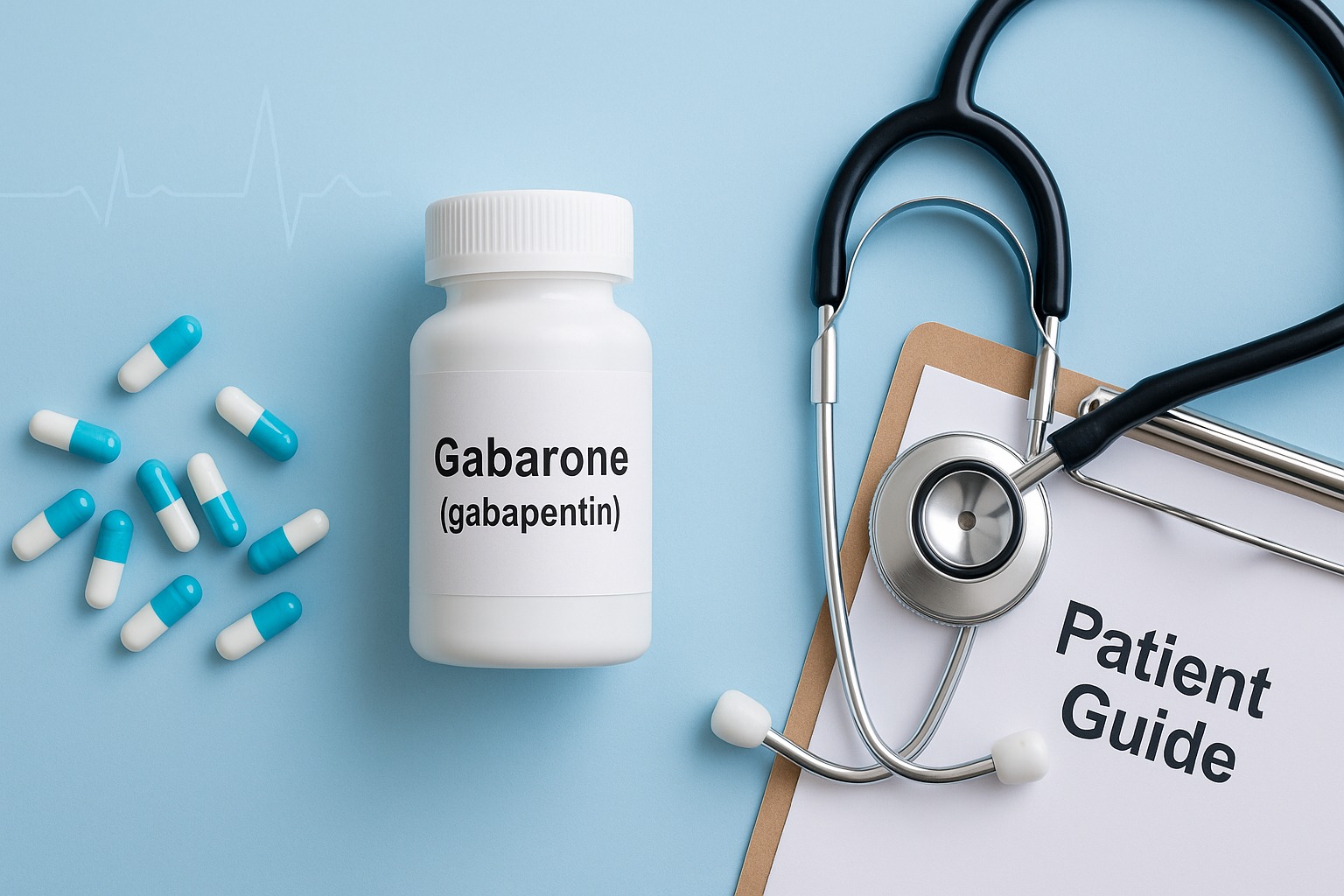Gabarone is a prescription medicine whose active ingredient is gabapentin. Doctors use it to help control partial seizures and to relieve nerve pain (such as pain after shingles, called postherpetic neuralgia). It affects how nerves send messages, which can calm overactive nerve signals.
This guide explains what Gabarone is, how it’s used, how to take it safely, possible side effects, and answers to the most-searched questions. It’s written in plain language so you can feel confident and prepared.
Quick disclaimer: This article is for education only and isn’t a substitute for your clinician’s advice. Always follow your own prescription label and pharmacist instructions.
What Is Gabarone?
- Generic name: gabapentin (immediate-release)
- Type of medicine: anticonvulsant/neuropathic pain agent
- What it does: helps calm overactive nerves in the brain and body
- How it’s supplied: capsules/tablets in several strengths and an oral solution (your pharmacy label will show the exact form you receive)
Not to be confused with Gaborone, the capital city of Botswana. This article is about the medicine Gabarone.
How Does It Work?
Nerves communicate using “signals.” After certain injuries or conditions, those signals can become too strong or too frequent. Gabapentin binds to a protein on nerve cells (the α2δ subunit of calcium channels) and reduces abnormal firing, which helps:
- Prevent partial seizures (used with other seizure medicines)
- Ease nerve pain such as postherpetic neuralgia
When Do Doctors Prescribe Gabarone?
Your provider may prescribe Gabarone to:
- Control partial (focal) seizures in adults and in children when used with other anti-seizure medicines
- Treat nerve pain after shingles (postherpetic neuralgia) in adults
Clinicians sometimes use gabapentin for other nerve-related pain based on clinical judgment. Only use it under medical supervision.
How to Take Gabarone (Patient-Friendly Overview)
Your exact dose and schedule are personalized. Always follow your label.
- With or without food: Either is okay—be consistent if possible.
- Measure liquids with a syringe/cup, not a kitchen spoon.
- Spacing: Take doses at evenly spaced times each day.
- Antacids: Aluminum/magnesium antacids can reduce absorption. If you use them, separate by at least 2 hours.
- Do not stop suddenly. Stopping abruptly can trigger seizures or severe symptoms. If you ever need to stop, your prescriber will taper your dose slowly.
Missed Dose
- Take it when you remember unless it’s almost time for the next dose.
- Don’t double up.
Driving & Alcohol
- Gabarone can cause sleepiness, dizziness, or blurry vision—especially when you’re starting or when doses change.
- Avoid alcohol and be cautious with driving or operating machinery until you know how you feel.
Common Side Effects
Many are mild and improve with time. Tell your care team if they bother you:
- Sleepiness, dizziness, fatigue
- Coordination problems, tremor, blurry vision
- Swelling in legs/feet, weight gain
- Nausea or stomach upset, constipation/diarrhea
- Dry mouth
Serious Side Effects (Get Medical Help Promptly)
- Mood or behavior changes: new or worsening anxiety, irritability, depression, or suicidal thoughts
- Breathing problems: slowed or difficult breathing (higher risk with opioids, sleep medicines, or lung disease)
- Severe allergic reactions/angioedema: swelling of face/lips/tongue, trouble breathing, rash or hives
- Severe skin reactions or widespread rash
- Unusual bruising or persistent fever
- Sudden severe weakness or confusion
Call your clinician right away if any of these occur. In an emergency, call your local emergency number.
Important Safety Tips
- Opioids, benzodiazepines, sleep aids, alcohol: using these with Gabarone can increase sedation and slow breathing—your prescriber will decide if the combination is safe and may lower doses.
- Kidney problems: doses are often adjusted—make sure your care team knows your kidney history.
- Older adults: higher risk of dizziness and falls—rise slowly, use handrails, keep rooms well lit.
- Pregnancy & breastfeeding: discuss benefits and risks with your clinician before starting or changing therapy.
- Children: only use exactly as directed by a pediatric specialist.
Storage & Disposal
- Store at room temperature away from moisture.
- Keep out of reach of children and pets.
- For expired or unused medicine, ask your pharmacist about take-back options.
Frequently Asked Questions (FAQs)
Q1. Is Gabarone the same as gabapentin?
A. Yes. Gabarone is a brand of gabapentin (immediate-release).
Q2. How long until it starts working?
A. Some people feel pain relief within a few days; others may need gradual dose adjustments over weeks. Seizure control is judged over time by you and your neurologist.
Q3. Can I take it once a day?
A. Immediate-release gabapentin is usually taken multiple times per day. Follow your label. Do not change the schedule without medical advice.
Q4. Is Gabarone addictive?
A. It isn’t an opioid, but misuse can occur. Take only as prescribed and store safely.
Q5. What if I need surgery or a new medicine?
A. Tell every clinician and pharmacist you take gabapentin. They’ll check interactions and advise whether to continue on the day of procedures.
Q6. I have restless legs—does Gabarone help?
A. A related medicine (gabapentin enacarbil) is specifically approved for RLS. Your clinician will choose the best option for you.
Quick Guide for Safe Use
- Take exactly as prescribed, at the same times daily.
- Don’t drink alcohol or combine with sedatives unless your prescriber approves.
- Don’t stop suddenly; ask about a taper plan if needed.
- Report new mood changes, breathing issues, or swelling right away.
- Keep regular follow-ups to review benefit, side effects, and dose.
Final Thoughts
Gabarone (gabapentin) can be a helpful tool for seizure control and nerve pain—when used exactly as prescribed. Keep open communication with your healthcare team, report new symptoms early, and never adjust your dose on your own.


Leave a Comment